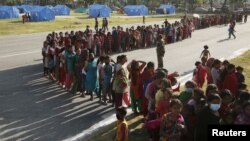International organizations and non-government groups in Nepal are warning the devastation caused by the April 25 earthquake has left thousands of girls and young women vulnerable to human traffickers.
Anti-trafficking campaigners said there is a need for greater attention to the protection of girls and women.
Hundreds of thousands of people in Nepal remain without shelter and possessions, leaving poor women and girls desperate and vulnerable to human traffickers, activists said.
Non-government organizations (NGOs) said the criminal networks are especially targeting Nepal’s rural communities, even using the cover of relief efforts to kidnap or lure women away.
The United Nations said up to 15,000 girls are trafficked each year from Nepal, forced into sex work as far away as South Korea and South Africa, although the vast majorities are lured to India where thousands work in brothels.
Anuradha Koirala, founder of anti-trafficking organization Maiti Nepal, said children are especially vulnerable amid the ongoing attention on relief and rehabilitation.
“All the areas which have been affected, these are the areas which have been affected very badly and where 80 percent of the children are trafficked,” Koirala explained. “Very few people are concentrating on this issue. We think these children are most vulnerable, we have to save them and we have to take care of them. We have ourselves have already rescued three children.”
The United Nations Children’s Fund (UNICEF) is calling for the creation of temporary places for learning, noting that almost 1 million children are not able to return to school due to damaged buildings.
An estimated 24,000 classrooms were damaged or destroyed in the earthquake, the most severe to hit Nepal in 80 years.
UNICEF said in areas such as Gorkha, Sindhupalchok and Nuwakot, over 90 percent of schools were destroyed. In Dhading, 80 percent of school buildings collapsed. Schools in other areas such as Kathmandu and Bhaktopur are being used as emergency shelters for earthquake survivors.
Maiti Nepal’s Koirala said rebuilding schools and raising awareness among rural communities to the threat posed by traffickers should be priorities.
“Our focus should be on reconstruction; the reconstruction of the schools’ first and education should be free, compulsory. The full international community, we should get together and work on prevention, prevention and protection of girls and children who have been survivors," she said. "We should take prevention programs, awareness programs to the villages because then only people can be aware and I think we can minimize trafficking."
UNICEF has expressed fear the recent gains made by Nepal in raising primary school enrollment to 95 percent may be lost due to the consequences of the earthquake.
But local health workers said people generally are increasingly desperate after losing everything in the quake, and are now vulnerable to traffickers with their promises of work and wages.
A U.S. State Department report found Nepali women and girls face forced labor in Nepal and India as domestic servants, beggars, factory workers and mine workers. Some find themselves in the adult entertainment industry. Other are trafficked to Malaysia, Hong Kong and South Korea, and even the nearby Chinese district of Khasa.
The report said while Nepal had failed to comply “with the minimum standards for the elimination of trafficking, significant efforts” were being made. But campaigners fear the gains may now be lost following the April 25 earthquake.










